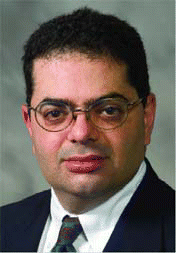Send Us Your Feedback We’d like to know what you think about our articles. Please feel free to respond to our stories by e-mailing ENToday@lwwny.com. When writing in, please include your full name, title, phone number, and e-mail address.
Explore This Issue
January 2008Almost 150 years ago, French physician Prosper Ménière first described the symptoms and probable cause of the inner ear disorder that bears his name. Unfortunately, despite decades of research, we’ve only made baby steps forward and Ménière’s still remains an idiopathic disease with controversial treatments and no cure, said Cliff Megerian, MD, Professor and Vice Chairman of Otolaryngology and Director of Otology and Neurotology at Case Western Reserve University Hospitals in Ohio.
With a prevalence rate of about 1,000 cases per 100,000 persons in the US population,1 this chronic disease typically starts between 20 and 50 years of age, increases in prevalence with age, affects men and women almost equally, and has unclear racial predispositions.2
Etiology
Since 1938, most otolaryngologists have recognized the causation of Ménière’s disease as endolymphatic hydrops, but this theory has now come into question, leaving the underlying cause(s) still unknown. Recent research indicates that Ménière’s disease probably has multiple etiologies, including autoimmune disorders, allergies, viruses, hereditary predisposition, and head injuries. The controversy is based on the fact that, upon autopsy, hydrops are not always found in persons with Ménière’s disease, yet they are commonly found in people who did not have Ménière’s type symptoms.3
Researchers are now looking less at hydrops and more specifically at the immunologic function of the endolymphatic sac, which is part of the immune system of the ear. Immune stimulation of the sac may disturb its fluid regulatory function or may cause hydrops to develop via independent mechanisms, such as the production of inflammatory mediators.4
Evidence also indicates that inhalant and food allergies may play a role in Ménière’s disease, causing dysfunction in the endolymphatic sac. Although more research is needed to substantiate that viruses are a possible cause, several investigators have found evidence of herpes simplex virus5,6 and varicella-zoster virus7 in the endolymphatic sac of patients with Ménière’s disease.
About one in three patients with Ménière’s disease has a first-degree relative with the disease; hereditary predisposition may be related to differences in anatomy of fluid channels within the ear or differences in immune response. Cases of post-traumatic Ménière’s disease are attributed to hydrodynamic changes caused by scarring from bleeding into the inner ear following a head injury or possibly ear surgery.4
Symptoms
 The dilemma we face today is that once Ménière’s disease is diagnosed, we know how to control the vertigo, but we don’t know how to stop the decline in hearing. We need insight now as to the mechanism that causes hearing loss in this disease so that we can develop inhibitors of this process in the future.
The dilemma we face today is that once Ménière’s disease is diagnosed, we know how to control the vertigo, but we don’t know how to stop the decline in hearing. We need insight now as to the mechanism that causes hearing loss in this disease so that we can develop inhibitors of this process in the future.-Cliff Megerian, MD
Patients with Ménière’s disease usually experience an attack characterized by a tetrad of symptoms: tinnitus, aural fullness in one ear, fluctuating hearing loss, and episodic rotational vertigo that leads to imbalance, severe nausea, vomiting, and sweating. During an attack, patients commonly have visual dependence and nystagmus.
Leave a Reply